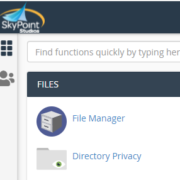What Goes Into a Website
Often times we’ve had a client ask about or be confused regarding what goes into a website and what is not actually a part of a website such as third party email & newsletter clients.

DOMAIN
All websites require a domain name which is the equivalent of an address in the real world. The domain name is not changeable once it is selected and a website may only have one domain name associated with it, although there can be lots of subdomains, they are always related off of the main domain. Of course a domain name can be changed to a different domain name, however all contents related to this domain must be transferred or rebuilt. There is no easy way to transfer site contents such as text, images, functioning modules and more without some time on the new site arranging and making sure the proper assets are in the proper folders. Some companies offer website transfer services, if you need help with this process, SkyPoint can assist 406-208-8733. GoDaddy also offers a cool solution for WordPress websites on their special WordPress hosting plan, included is a easy transfer tool that works pretty well with limited requirement for rebuilding after the transfer.
HOSTING
All websites require hosting to get them live on the web itself. The hosting is a lot like the actual physical structure in real estate, it is what will hold all of the websites content and it’s speed and power will directly correlate to how well the website performs. Actions like downloading images and showing slideshows are points that can show slower hosting solutions such as shared servers that host 1,000’s of websites. An ideal situation for any website is to use resources only when necessary and to pay accordingly. The new virtual servers from companies like GoDaddy and Amazon Cloud allow small businesses to purchase affordable plans that easily scale up to cover large traffic when the business takes off.
CODE/PLATFORM
All websites require some code to tell the browsers how to display the content. Content is the most crucial part of any website, and will ultimately be the deciding factor of whether the site is successful or not. To a lesser degree, but still very important is the code and platform choices for the website. Many sites on the web, and certainly most of the original websites were built by hand without the use of a platform. Platforms are a pre-constructed set of codes that work together to offer a structure that would take a long time to hand build up to that still offers customize-ability. These platforms eventually took off and offered more features and power than ever before, WordPress being the main leader of this revolution in website design. Now most websites on the web are built on some sort of platform, BootStrap, WordPress, Joomla, Medium, Drupal, Magento, Volusion, Big Commerce, etc.
These pre-built website themes offer huge advantages in easy web development that does not require knowledge of programming. PHP or ASP are the main two flavors of programming languages that create the “engine” behind most popular website platforms. WordPress for example is running on PHP, and that gives it great power to dynamically pull together whatever the user may be looking for inside the database. The WordPress database is running mySQL, which is like a library of data related to the website organized and categorized efficiently.
If the choice is to not use a platform to build a new website, a lot of the functionality could be achieved that WordPress and others offer, it would take installing all of the seperate technologies (XAMP stack) and building the site structure entirely from scratch or web libraries stitched together (Bootstrap).
EMAILS/NEWSLETTERS
Email accounts that are custom such as you@yourbusiness.com are run through the business domain name by the third party that they are set up through, Google Gmail email can be set up here. The hosting and domain registration do not have anything to do with the email set up. Some domain registrants and hosting providers also offer email solutions, it is generally advised against using these accounts for business purposes as they provide a poor user experience. Instead use Google Gmail Apps or Microsoft Outlook. Notice that if a domain name’s registration expires, the associated email accounts will also go down until the domain is re-registered. The billing for these two products will be at different vendors so it is a good idea to keep and eye on the re-registration dates to make sure there are no account outages.
Newsletters are typically not run out of a website because the hosting server required to run a successful email blast out (1,000+ emails) is quite different than what is used to run a website. Specially designed servers made  just for email delivery is what companies like Constant Contact and MailChimp use to send out their email lists. They often avoid spam statuses on their newsletters almost entirely due to the fact that they run special email high-end servers which the mail providers are aware that they are more legitimate emails.
just for email delivery is what companies like Constant Contact and MailChimp use to send out their email lists. They often avoid spam statuses on their newsletters almost entirely due to the fact that they run special email high-end servers which the mail providers are aware that they are more legitimate emails.
Those are the main components of today’s digital properties and what goes into a website. For questions, please fill out the form located here.



























Leave a Reply
Want to join the discussion?Feel free to contribute!